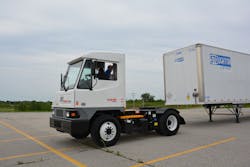When Kalmar Ottawa decided it was time to develop a new terminal tractor, the company went straight to its customers for help.
The company invited a range of customers – 60 drivers, maintenance technicians, safety directors and management people from over 25 companies – to the plant in Ottawa, KS, to discuss what would eventually become the T2 Terminal Tractor. Overall, reliability, serviceability and driver productivity topped customers’ list of musts for the T2.
To gain input, the company created a white-walled idea room that contained a full-scale cab mock-up and a 50% chassis model for customers, sales, service and parts professionals, and Kalmar Ottawa representatives to collaborate and exchange ideas.
“We wanted them to touch and feel, sit in the driver seat, and talk to us about all of their ideas,” said Dave Wood, vice president of sales and marketing, during last week’s press event and T2 Ride and Drive in Kansas City. “We challenged them to think down the road 10 or 15 years and try to visualize the tractor configuration and the technologies they would need then.”
Technical features of the T2 include:
-
A modular frame design with an open C-channel frame rail chassis concept
-
Powder-coated frames to resist corrosion
-
A steel cab to reduce corrosion
-
A wider rear door opening that is almost 20% larger for easy entry and exit
-
A cab that is 5 in. wider and taller at the front for driver headroom, and 5 in. deeper for driver gear stowage
-
Lift cylinders that include standard spherical bushings at the top and bottom of the cylinders to improve durability and performance
-
Four-inch cylinders lift trailers faster by 18%
-
Added roll-over protection
-
Improved driver visibility
-
Two-year, 6,000-hour warranty
According to Jacob Sipple, who works with marketing and dealer operations manager Bob McTernan, in order to enhance serviceability and keep drivers safe, the T2 was designed to keep drivers from climbing on the truck for routine maintenance checks. The T2 allows drivers to check engine oil, windshield washer fluid and transmission fluid while standing on the ground, eliminating the chance of slips and falls, Sipple said.
During the event, company representatives also said that “trusted durability” and maximizing uptime also came up as key requests during the research phase for T2.
“With our trucks you can move a trailer in about one-third of the time,” according to a company video that compared the T2 to over-the-road tractors. “We put complete control in the drivers’ hands. T2 provides maximum maneuverability and control to move the heaviest loads across challenging terrains. It can provide more than 20% in fuel savings a year.”
The fifth wheel allows drivers to control the trailer lift, the company said. And the total time it takes to hook up a trailer is less than 50 seconds, according to the company.
“It is about getting more done in less time and meeting your bottom line,” Sipple said, noting that the T2 has made trailer movement and maneuverability easier.
Since Kalmar’s T2 market launch in January, it has built 625 T2s and has another 800 on order, selling more than 1,400 of the new tractors. In its newly renovated plant, the company produces as many as 22 tractors a day.
“To stay at the head of the competitive pack, our factory production processes and equipment had to be updated,” Wood said. “We invested heavily in factory and process improvements, training and equipment to enable us to increase our production capacity and capabilities – ensuring that we continue to lead the industry for many years to come.”
About the Author

Cristina Commendatore
Cristina Commendatore is a past FleetOwner editor-in-chief. She wrote for the publication from 2015 to 2023.
